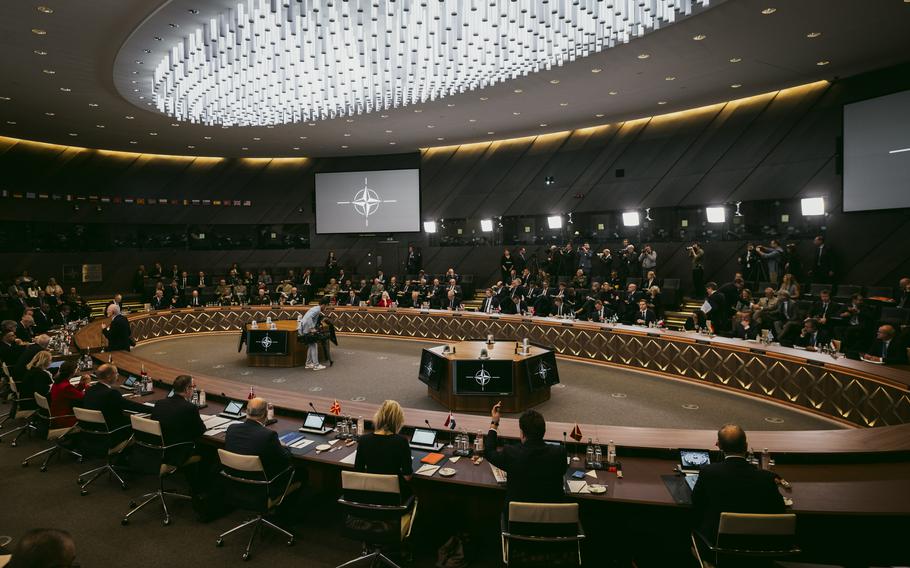
NATO Defense Ministerial meetings at NATO headquarters in Brussels, Belgium, in October 2023. (Chad J. McNeeley/Department of Defense)
WASHINGTON — The 32 members of the NATO military alliance will meet in Washington next week to project a united front on Ukraine and its fight against Russian aggression, but there could be some fractures behind the harmonious facade.
Bulgarian President Rumen Radev last week refused to lead his country’s delegation to the NATO summit due to disagreements with Bulgaria’s position in support of Ukraine.
Slovakia’s prime minister, Robert Fico, claimed last month that he was the target of an assassination attempt because his opposition to arming Ukraine deviated from the European mainstream.
And Hungary has continued to maintain close ties with Russia and resist pressure to help Ukraine economically or militarily. Prime Minister Viktor Orban urged Ukraine on Tuesday to consider a cease-fire to speed up peace talks.
More cracks in the alliance could emerge Sunday with the potential electoral triumph of France’s main far-right party. The party, National Rally, has a history of pro-Russia sympathies, and last year abstained in a vote on France’s security pact with Ukraine.
Outgoing NATO Secretary General Jens Stoltenberg acknowledged the split in opinion on Ukraine in a news conference with Orban in June but expressed optimism in the alliance ultimately standing together in solidarity.
“We are 32 allies, and sometimes there are different opinions, but we have proven again and again that we are able to overcome them and find a common way forward,” he said.
Orban has assured NATO that Hungary will not oppose the expected announcement next week of a new mission in Germany to coordinate aid to Ukraine as well as a long-term financial pledge by the alliance to provide military support. But Orban also made clear that Hungary will not contribute personnel or funds for the efforts.
For now, any disagreements among NATO allies concerning Ukraine seem to be superficial cracks in the veneer of the alliance rather than at its foundations, according to Sean Monaghan, a U.K. visiting fellow with the Center for Strategic and International Studies, a Washington think tank.
“Gaining consensus in the face of differing national positions on critical issues is normal business for NATO, and I would expect any cracks to be patched up by the time we get to Washington next week,” he said.
The main aim of the summit will be to maintain and show unity, especially as the alliance marks a landmark 75th anniversary while war rages in Europe, and its largest member — the United States — moves into a highly consequential presidential election, Monaghan said.
The public is unlikely to see the kind of discord that accompanied last year’s summit in Lithuania, when open debate about Ukraine’s future with the alliance caused Ukrainian President Volodymyr Zelenskyy to lash out in frustration, he said.
“We won’t see any last-minute debates in public this time. We’ll see a unified position on Ukraine,” Monaghan said.
Behind the scenes, countries such as Hungary and Slovakia could cause problems, but the biggest sources of potential obstacles will be the U.S. and Germany, said Luke Coffey, a senior fellow at the Hudson Institute, a conservative think tank.
“Hungary and Slovakia are very loud with their rhetoric, but behind closed doors, they tend to be more cooperative and pragmatic. If we wanted to do something with Ukraine inside NATO, and the only voice against it was Hungary’s, there are ways to make Hungary come around,” he said. “But if Berlin or Washington is against something, they’re too big. They’re too big to try to influence or persuade.”
Washington and Berlin are “dead set against” extending an invitation for Ukraine to join NATO, he said. However, support for arming Ukraine to repel Russia’s invasion remains strong in NATO and is unlikely to change in the near term.
“Is the political will still there to do this? So far, I think the answer is yes,” Coffey said.
That resolve is expected to continue even as various countries head to the polls. Coffey noted widespread fears in 2022 that the election of far-right leader Giorgia Meloni as Italy’s prime minister would spell disaster for Ukraine never came to pass.
“Now, Italy is one of the strongest advocates for arming Ukraine,” he said.
The glue holding the NATO alliance together ultimately goes beyond each member nation’s shifting politics, Monaghan said.
“NATO is an alliance of liberal democracies,” he said. “The democracies have elections, and the positions of allies change, but I don’t think they change so fundamentally to turn cracks into massive fissures. NATO is an alliance that’s built on a community of shared values. It always has been, and I think it will continue into the future.”